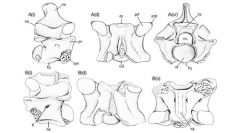

 Geodiversitas
33 (3) - Pages 411-449
Geodiversitas
33 (3) - Pages 411-449Two fossil-bearing levels at Griesbeckerzell (the central part of the North Alpine Foreland Basin; Early Badenian, Mittlere Serie of the Upper Freshwater Molasse) have produced a rich reptile fauna that includes a large number of snakes, i.e. Grisbeckerzell 1b (OSM E, 15.0-14.9 Ma): Boidae: Python sp.; Colubridae: “Coluber” cf. caspioides; Viperidae: Vipera sp. (“oriental vipers” group) or Daboia sp.; Griesbeckerzell 1a (beginning of unit OSM F, 14.77 Ma): Boidae: Bavarioboa aff. hermi, cf. Bavarioboa sp., Python sp.; Colubridae: “Coluber” cf. caspioides, Coluber hungaricus, “Coluber” sp., Texasophis cf. meini, Natrix sp.; Elapidae: Micrurus cf. gallicus; Viperidae: Vipera sp. (“Oriental vipers” group), Vipera sp. (“European vipers” group; “Vipera aspis complex”). The Miocene Climatic Optimum (MCO) is documented in central Europe by the presence of highly thermophilous reptile taxa, including Python sp., which is the most thermophilous reptile known from the European Neogene. The presence of Python sp. in Griesbeckerzell 1a pushes up the last appearance date (LAD) of this large Booidea in central Europe into the early Middle Miocene. The dramatic decrease in temperatures after 14.0 Ma (i.e. below 16°C in mean annual air temperature) was most probably responsible for the extinction of the European non-Erycinae Booidea, regardless of food competition. The genus Bavarioboa (Bavarioboa aff. hermi) and possibly “Coluber” caspioides (“Coluber” cf. caspioides) both have their LADs in Griesbeckerzell 1a; Coluber hungaricus probably represents the earliest appearance (FAD) of this colubrid snake. Palaeoclimatic analyses of the herpetofauna indicate for both Griesbeckerzell levels humid conditions of between 750 and 1 025 mm mean annual precipitation. Temperature estimates combined with palaeobotanical data indicate a warm, subtropical climate with mean annual temperatures of 18.6 to 20.8°C, cold month temperatures with 12.6 to 13.3°C, and warm month temperatures with 25.1 to 28.1°C.
Squamata, Boidae, Colubridae, Elapidae, Viperidae, Miocene Climatic Optimum, North Alpine Foreland Basin, palaeoclimate